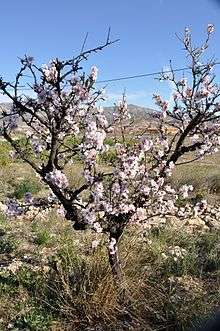Agost
Agost (Valencian pronunciation: [aˈɣost]) is a small town in Alicante (province), located about 18 km from the provincial capital Alicante. For centuries the town was known for ceramics, a reputation which it maintains to the present day.

Understand
Agost was first settled by the Iberians, and later inhabited by the Moors, who built a now-ruined castle on the hilltop in the centre of town. After the Reconquista, the town belonged to the crown of Castile for a few years, before being incorporated into the Kingdom of Valencia in the late 13th century. Agost gained municipal autonomy at the end of the 17th century.
Due to the rich clay deposits located just outside the city, the town developed into a centre of pottery. Although many of the old workshops have now closed, eleven potteries still remain in town, six of them still producing traditional wares.
Because of its distance from the coast, the town has not been inundated by mass tourism and has retained its local identity. Today its primary economic activity is ceramics production and agriculture.
Get in
By bus
From Alicante, Autocares Agostense (tel. +34 965 280 657) runs three buses daily, departing at 09:00, 13:58 and 20:30, with the journey taking just half an hour.
See
- 🌍 Església de Sant Pere Apòstol d'Agost (Iglesia de San Pedro Apóstol / Church of Sant Pere Apòstol), Plaça de la Constitució, 6, ☎ +34 965 691 087. The centre of the picturesque old town is dominated by the parish church, built in the 16th century and expanded in the 18th century.
- 🌍 Ermita de les santes Justa i Rufina (Ermita de las Santas Justa y Rufina), Carrer de les Canteres, 44. A small chapel built in 1821.
- 🌍 Castell d'Agost (Castillo de Agost / Agost Castle). Besides foundations and an outer wall, very little remains of the Moorish-era fortress, but good views of the town can be had from the top of the hill.
- 🌍 Museu de Cantereria (Museo de Alfarería / Pottery Museum), Carrer Teuleria, 11, ☎ +34 965 691 199, e-mail: museo@museoagost.com. Tu-Sa 09:00-15:00, Su 10:00-14:00; closed all of Jan. Established by German ethnologist Ilse Schütz, the museum is located in a former 20th-century ceramics factory with an original Arabic kiln. Displays in each room illustrate the production process, from collecting the clay in nearby quarries to firing in wood-fired furnaces. Also on display is a collection of unique pieces donated by town residents. €2.50.
Do
Buy
- 🌍 Mercadillo, Avinguda Verge de la Pau. Th mornings. The weekly street market is good for picking up fresh produce and various odds and ends.
Eat
- 🌍 Restaurante Nou Palacio, Avinguda del Doctor Fleming, 12A, ☎ +34 965 691 722. Serves home-style traditional meals. Set menu €9 (weekdays), €11.50 (weekends).
Drink
Sleep
- 🌍 Casa Rural La Fabrica, Carrer Teuleria, 12-18, ☎ +34 965 691 893, e-mail: info@lafabrica.es. Check-in: 16:00-22:00, check-out: 12:00. This rustic casa rural has four self-sufficient apartments with kitchenettes, TV, and free Wi-Fi. Doubles €45+.
Connect
Go next